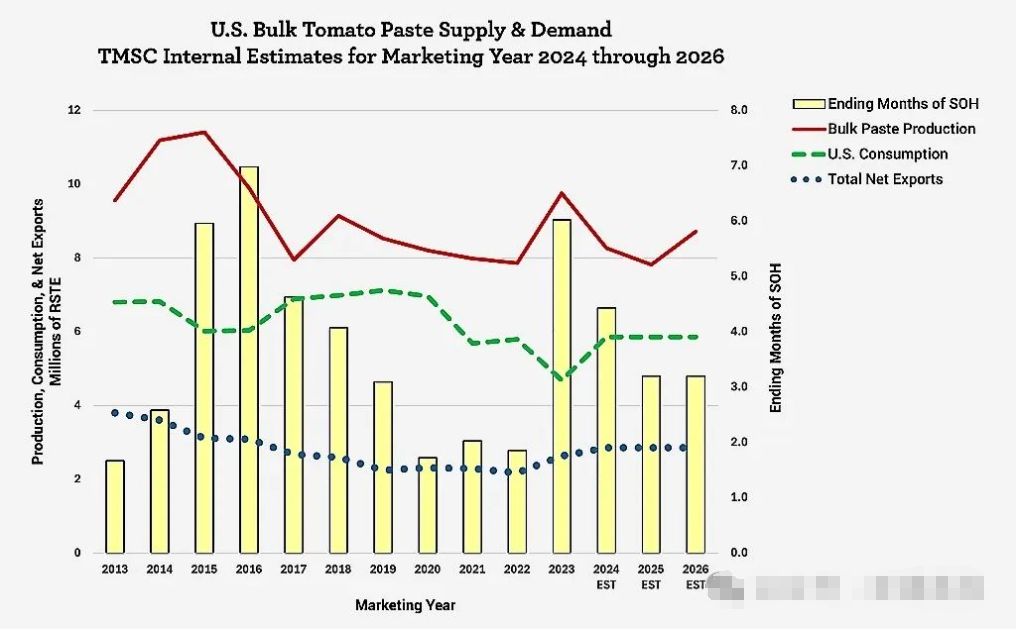Reasons for the Closure of California Tomato Factories, Their Prospects and Implications for China's Tomato Industry
I. Main Reasons for the Closure of California Factories II. Prospects of the California Tomato Industry III. Implications for China's Tomato Industry
Reasons for the Closure of California Tomato Factories, Their Prospects and Implications for China's Tomato Industry
I. Main Reasons for the Closure of California Factories
- Imbalance between Supply and Demand
• According to the article, the core reason for Del Monte Foods to close its Hanford factory lies in the market situation characterized by high inventories and low demand.
• Industry insiders pointed out that the processing capacity of California's tomato industry far exceeds the actual production demand. Currently, the capacity of 14 processing factories can reach 12 million tons, but the actual processing volume in 2024 was only about 10 million tons, highlighting a prominent imbalance between supply and demand. - Stability of Market Structure
• Since 2020, the number of California's tomato processing enterprises has remained basically stable, but the overall production capacity has not been adjusted to adapt to the reality of the declining market demand.
• Merchants in the market (mainly selling to secondary processing enterprises) account for 87% of the total production capacity, while the demand of remanufacturers (for internal production use) is limited, resulting in low capacity utilization rates. - Rational Adjustment of the Industry
• To maintain the health of the industry, reducing the planting area has become a consensus. Mike Montna, president of the California Tomato Growers Association (CTGA), clearly stated that reducing the scale of planting and processing to avoid inventory backlogs is a necessary means to ensure the sustainable development of the industry. - Cost Pressures and Global Competition
• High operating costs, labor costs and water shortages have put the California tomato processing industry under tremendous pressure. In addition, competition from other tomato-producing regions around the world (such as China, Spain, and Italy) has further intensified the scramble for market share, forcing enterprises to optimize their production capacity 
II. Prospects of the California Tomato Industry
- Capacity Adjustment and Contraction
• It is expected that California's tomato production plan will be further reduced in 2025, with a target output of approximately 9.5 million tons, which is lower than the actual production volume in 2024. This reflects the trend of rational industry adjustment and downsizing. - Optimization of Capacity Structure
• California will continue to rely on existing large processing enterprises, such as Morning Star, and improve efficiency through capacity concentration and factory upgrades.
• Small-scale or inefficient factories will gradually withdraw from the market, and the industry will develop in a more efficient and centralized direction. - Focus on Changes in the Demand Side
• In the future, enterprises will pay more attention to matching market demand and reduce blind expansion. Especially in the face of consumers' demands for high-quality, organic and sustainable products, brand owners will further optimize their product lines. For example, Del Monte Foods has clearly stated that its branded tomato product lines will not be affected by the factory closures.
III. Implications for China's Tomato Industry
- Balance between Supply and Demand and Market Orientation
• The fundamental reason for the closure of California factories lies in the imbalance between market supply and demand, which serves as an important warning for China's tomato industry.
• Chinese tomato processing enterprises should closely monitor market demand, reasonably plan the planting area and production capacity, and avoid overcapacity and inventory backlogs. - Upgrading of the Industrial Chain and Brand Building
• Branded enterprises in California, such as Del Monte Foods, have achieved differentiated competition through branding and diversified product lines, maintaining a certain market share.
• Chinese tomato enterprises should increase their investment in research and development, enhance the added value of products, develop organic, healthy and high-end tomato products, break away from the situation of low-end raw material competition, and enhance their global market competitiveness. - Centralized and Large-scale Development
• The California tomato industry has improved production efficiency through factory integration and capacity concentration. China should learn from this practice, encourage leading enterprises to carry out mergers and acquisitions, eliminate backward production capacity, and form an efficient, centralized and large-scale industrial layout. - Cost Control and Sustainable Development
• In the face of global competition, Chinese tomato processing enterprises should pay close attention to production costs, especially the efficiency of water resource utilization, energy consumption and labor costs. Through technological innovation and intelligent upgrades, sustainable development can be achieved.
• Meanwhile, actively respond to the requirements of the international market for environmental protection and sustainable production, and promote green and low-carbon development to gain more market recognition. - Global Market Competition Strategies
• When faced with a decline in the market, California processing enterprises chose to actively adjust production capacity instead of overproducing. This strategy is worthy of reference for Chinese enterprises. Chinese enterprises should avoid low-price competition in the global market, reasonably plan the export scale, improve product quality and brand image, and steadily expand their international market share.

Summary: The adjustments in the California tomato industry reflect the trends of supply-demand balance, cost pressures and market rationalization. China's tomato industry should draw lessons from it, optimize the layout of production capacity, strengthen brand building and innovation, and promote high-quality development of the industry. At the same time, by reducing low-end production capacity, improving efficiency and sustainability, a modern tomato industrial chain with international competitiveness can be built.
